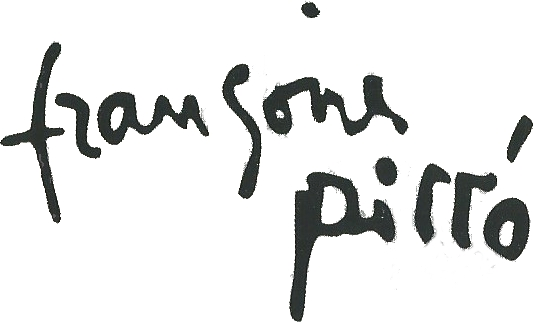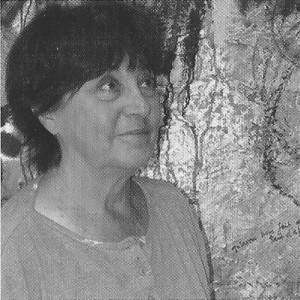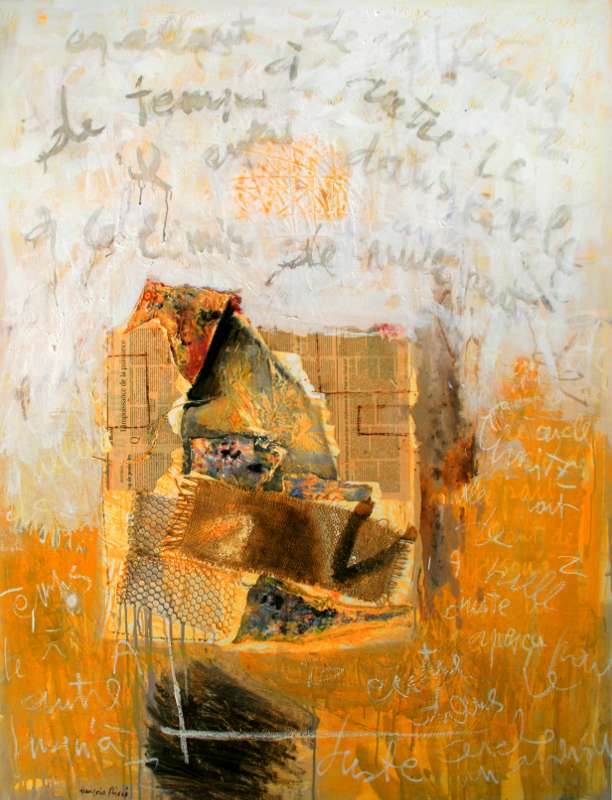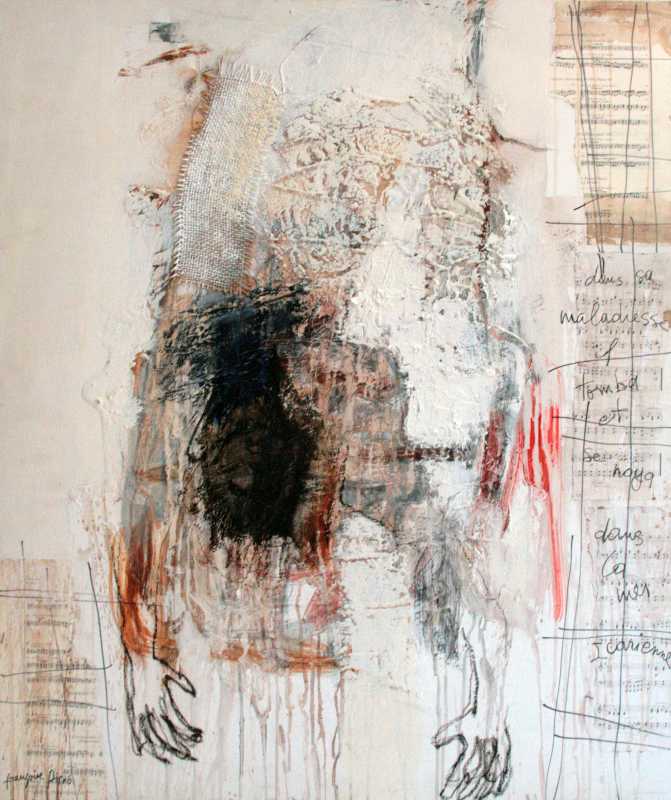I don’t oppose the figurative and abstract in a painting. A painting should be figurative and abstract at the same time.
Nicolas de Staël
I don’t oppose the figurative and abstract in a painting. A painting should be figurative and abstract at the same time.
Nicolas de Staël
L’oiseau de l’enfant 4, 146×114, oil on canvas, 2008
Françoise Pirró’s works are very elaborate and often reworked to achieve the ultimate stage when you thought the painting couldn’t accept the most insignificant accent, the most remarkable remorse… is achieved.
The successive layers, as for a palimpsest, keep visible the successive steps. This well-thought creation, well built and structured beforehand, can be identified at once, even if Françoise Pirró’s creativity is guided by the use of materials. Certainly, her inner needs come first, judging by the intensity of her emotional burden, but are unspoken back.
Her drawing style is determined and vibrant, perfectly illustrating memories which support persons and things.
Françoise Pirró uses collage. Her drawings are made from scratch out of her drawing note book to keep the spontaneity of her last vibes. As if these sketches were claiming to witness moments of intense life, words or short poems inhabit the painting and give rhythm to the already incised, not to say lacerated, canvas. This combination of paint, collage, drawings and texts bring amazing energy to the paintings.
Her works take us far from the tumult of the World, although we are constantly surrounded by the World, with its joy and sorrows, its’ suffering, its secret tragedies, its degradations and lost lives.
Definite spaces are marked out with rectangle or square shapes on the canvas. These ‘ windows enable dreams to spread out and meditation to double everyone’s angle of approach. Anyway, two paradoxes can be noticed : the more Françoise Pirró works on her canvas, the more her works become lighter ; the reality fades, to come back with a greater strength. And this vigour holds moments which inspire us thanks to their sweet music and their simple and open poetry.
René Trusses
August 2009
Françoise Pirró’s works are very elaborate and often reworked to achieve the ultimate stage when you thought the painting couldn’t accept the most insignificant accent, the most remarkable remorse… is achieved.
The successive layers, as for a palimpsest, keep visible the successive steps. This well-thought creation, well built and structured beforehand, can be identified at once, even if Françoise Pirró’s creativity is guided by the use of materials. Certainly, her inner needs come first, judging by the intensity of her emotional burden, but are unspoken back.
Her drawing style is determined and vibrant, perfectly illustrating memories which support persons and things.
Françoise Pirró uses collage. Her drawings are made from scratch out of her drawing note book to keep the spontaneity of her last vibes. As if these sketches were claiming to witness moments of intense life, words or short poems inhabit the painting and give rhythm to the already incised, not to say lacerated, canvas. This combination of paint, collage, drawings and texts bring amazing energy to the paintings.
Her works take us far from the tumult of the World, although we are constantly surrounded by the World, with its joy and sorrows, its’ suffering, its secret tragedies, its degradations and lost lives.
Definite spaces are marked out with rectangle or square shapes on the canvas. These ‘ windows enable dreams to spread out and meditation to double everyone’s angle of approach. Anyway, two paradoxes can be noticed : the more Françoise Pirró works on her canvas, the more her works become lighter ; the reality fades, to come back with a greater strength. And this vigour holds moments which inspire us thanks to their sweet music and their simple and open poetry.
René Trusses
August 2009
La chute, 100×81, oil on canvas, 2008
To me, the object is a springboard to imagination and a way to become visible. Starting from it, I try to offer a new vision of things, more realistic than reality. I need the subject in its known or invented shapes, sketched or precise to overcome a balance, where colors, drawing styles and material and writing are opposed to each other in a dedicated space: the canvas. I believe in obvious or hidden links, secret harmony and in signs.
I write quotations which reflect my thoughts on the walls of my workshop. Words are important and meaningful, bearers and supporters of emotions, elements of the painting, unifiers or destroyers (whatsoever…) in the genesis of the works, where secret ‘rendez-vous’ occurs.
Françoise Pirró
To me, the object is a springboard to imagination and a way to become visible. Starting from it, I try to offer a new vision of things, more realistic than reality. I need the subject in its known or invented shapes, sketched or precise to overcome a balance, where colors, drawing styles and material and writing are opposed to each other in a dedicated space: the canvas. I believe in obvious or hidden links, secret harmony and in signs.
I write quotations which reflect my thoughts on the walls of my workshop. Words are important and meaningful, bearers and supporters of emotions, elements of the painting, unifiers or destroyers (whatsoever…) in the genesis of the works, where secret ‘rendez-vous’ occurs.
Françoise Pirró
Forgetting landmarks, forgetting space and time, forgetting yourself out: it’s necessary to go that far to fathom the world of glass of Françoise Pirró. She invites us to discover her personal universe, in which silence screams and words escape, meaning more than their basic meaning, as many bridges of glass which lead to this babybird who haunts her paintings.
E. Butet
Forgetting landmarks, forgetting space and time, forgetting yourself out: it’s necessary to go that far to fathom the world of glass of Françoise Pirró. She invites us to discover her personal universe, in which silence screams and words escape, meaning more than their basic meaning, as many bridges of glass which lead to this babybird who haunts her paintings.
E. Butet

Seeking for a free technique, Françoise Pirró has studied the painter William Turner in London. But she went through a progressive process of thoughts in the 80s which led her to vehemently paint her inner imaginary world, trying not to imitate reality.
In the evolution of her works, the painted space remains confident, movable and incisive, inseparable from the disruptions of her entire being. Pencils, chalk sticks, pigments, oils, lyrical language, fragments of life remind us of the spiritual dimension that the painter rubs off on material.
In the polyphony of colours, images, always free, are never silent. Patterns and lights interpenetrate by sonorous touch, thus inviting intimate deciphering.
The poet-painter sets the tone, etches her poetic prose on the canvas, and sometimes adds quotations of René Char, André Gide, Vladimir Jankélévitch or Yi Munyol, knowing that it’s impossible to « report » everything on a painting.
With her tactile perception of colours and visible things, halfway between tradition and modernity, François Pirró who refuses to set up a simple organisation of signs on her painting, makes a timeless consciousness of the blooming moment.
Danièle Malis
Curator of the Edgar Mélik Museum, Cabriès
Seeking for a free technique, Françoise Pirró has studied the painter William Turner in London. But she went through a progressive process of thoughts in the 80s which led her to vehemently paint her inner imaginary world, trying not to imitate reality.
In the evolution of her works, the painted space remains confident, movable and incisive, inseparable from the disruptions of her entire being. Pencils, chalk sticks, pigments, oils, lyrical language, fragments of life remind us of the spiritual dimension that the painter rubs off on material.
In the polyphony of colours, images, always free, are never silent. Patterns and lights interpenetrate by sonorous touch, thus inviting intimate deciphering.
The poet-painter sets the tone, etches her poetic prose on the canvas, and sometimes adds quotations of René Char, André Gide, Vladimir Jankélévitch or Yi Munyol, knowing that it’s impossible to « report » everything on a painting.
With her tactile perception of colours and visible things, halfway between tradition and modernity, François Pirró who refuses to set up a simple organisation of signs on her painting, makes a timeless consciousness of the blooming moment.
Danièle Malis
Curator of the Edgar Mélik Museum, Cabriès

1946
Born on August, 23rd, in Marseille
1958
École des Beaux-Arts de Marseille
1964
Prix de la Roque d’Anthéron. Prix de la Mer, Marseille
1965
Exhibition Salon des Indépendants, Paris
Exhibition Clarksville Galleries, New York
Salon de la Jeune Peinture, Musée Longchamp, Marseille
Exhibition Galerie Peuser, Buenos Aires
First prize, City of New York
First Prize, modern composition, Nice
Nominated for the Prix Othon Friesz, Paris
1966
First Prize, Sausset-les-Pins
1968
XIVe Confrontation d’Ambierle, Exposition d’aquarelles, Martigues
First Prize, Festival d’Avignon
1969
Salon de la Mer et de la Provence
1971
“Cent peintres provençaux de 1900 à 1970”, Musée Cantini, Marseille
TV broadcast “Pays Show” with Pierre Cordelier
1974
Settlement in Cabriès
1975
Exhibition Galerie Jouvène, Marseille
1976
Exhibition “Formats”, Chapelle du Grand Couvent, Cavaillon
Grand Prix de la Décennie, Sausset-les-Pins
1978
Salon des Indépendants, Aix-en-Provence
1980
Special guest at the Salon du Conseil Général des Bouches-du-Rhône, Marseille
1981
Galerie Saint-Hubert, Lyon (et 1983, 85, 87, 89, 92, 95, 98)
Exhibition Château-Musée de Cabriès
1982
XXIIè Salon des Arts Plastiques, Port-de-Bouc
1984
Salon Comparaisons, Paris
1985
Exhibition “Autour de Bonnard”, Conseil Général des Bouches-du-Rhône, Marseille
1987
Special guest at the Salon de la Biennale de la Société Nationale des Beaux-Arts, Paris
1989
Exhibition Galerie de l’Atelier, Nîmes
Exhibition Galerie du Vieux Belfort, Belfort (et 2011)
Exhibition Galerie La Main d’Or, Saint Paul de Vence
1991
Exhibition Art Center, New York (et 1993)
1994
Exhibition Théâtre National La Criée, Marseille
1996
Exhibition Galerie Ginza, Tokyo
1ère Biennale Internationale des Arts, Hôtel de Ville de Rosny-sous-Bois
9ème Rencontre du Château La Conspaude, Saint-Émilion
L’art actuel France-Japon, exhibiton patronized by the French Embassy in Japan, Tokyo
1997
Festival Arts et Musique Franco-Japonais, Musée de Millau
1998
Exhibition Galerie Anoka, Bruxelles
2000
Exhibition Galerie Berlioz, Sausset-les-Pins
2001
Exhibition Galerie Sérignan, Avignon (et 2011)
Foire d’Art Contemporain, Arténîm, Nîmes
2002
Exhibition Galerie Vendôme, Paris (et 2010, 2012)
2003
Collective exhibition “Autour de Cézanne”, Artéum, Musée de Chateauneuf-le-Rouge
Collective exhibition, Passau, Allemagne
2005
“Ateliers du sud, l’esprit des lieux”, Claude Darras, éditions Edisud
2007
Musée Edgar Mélik, Cabriès
2009
Exhibition au Carmel, Tarbes
Théâtre Toursky, Marseille
2010
Rencontres de Création Contemporaines, Martigues
2011
Galerie Ardital, Aix-en-Provence
Saint Gervais
2012
Exhibition de groupe “La Grande Galerie”, “La Fabrique”, Drôme
2013
“L’Oustau pèr touti”, Cabriès
“Pavillon M”, Marseille (dans le cadre de Marseille Capitale de la Culture 2013)
2014
“La Colombe d’Or”, Houston, Texas
Chapelle Saint-Pierre, Saint Chamas
Galerie Bartoli, Marseille
“Jacques et Françoise, Histoires et paroles” (Prévert, Pirró), show in Cabriès
2015
Galerie Saint-Hubert, Lyon
2016
16è Rencontres de Création Contemporaine, Martigues
Quel ancien temps il fait partiellement en nous, 116×89, oil on canvas, 2012


